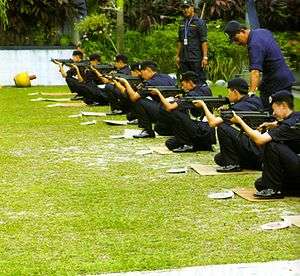Royal Malaysia Police
The Royal Malaysia Police (often abbreviated RMP) (Malay: Polis Diraja Malaysia (PDRM)), is a (primarily) uniformed federal police force in Malaysia. The force is a centralised organisation. Its headquarters are located at Bukit Aman, Kuala Lumpur. The police force is led by an Inspector-General of Police (IGP) who, as of 4 May 2019, is Abdul Hamid Bador.
| Royal Malaysia Police Polis Diraja Malaysia | |
|---|---|
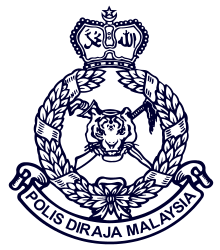 Logo of the Royal Malaysia Police | |
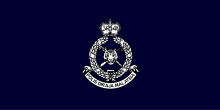 Flag of the Royal Malaysia Police | |
| Abbreviation | RMP/PDRM |
| Motto | Polis dan Masyarakat, Berpisah Tiada "Police and The Community, Will not Separate" |
| Agency overview | |
| Formed | 25 March 1807 |
| Preceding agencies |
|
| Volunteers | Sukarelawan Simpanan Polis Diraja Malaysia Sukarelawan Siswa Polis Diraja Malaysia |
| Jurisdictional structure | |
| National agency (Operations jurisdiction) | Malaysia |
| Operations jurisdiction | Malaysia |
| Size | 330,803 km2 (127,724 sq mi) (Population: 32767900) |
| Legal jurisdiction | National |
| Governing body | Government of Malaysia |
| General nature | |
| Operational structure | |
| Headquarters | Bukit Aman, Kuala Lumpur, Malaysia |
| Sworn members | 130,401 (February 2018) |
| Elected officer responsible | |
| Agency executives | |
| Parent agency | Ministry of Home Affairs |
| Child agencies |
|
| Facilities | |
| Police stations | 1,000 |
| Police cars | Proton Preve, Proton Inspira, Mitsubishi Lancer Evolution X, Mitsubishi Lancer 2.0 GTS, Mitsubishi Outlander, Toyota Hilux, Proton Inspira, Honda Civic, Proton X70. |
| Police boats | Marine Alutech Watercat M14 |
| Website | |
| www | |
The constitution, control, employment, recruitment, funding, discipline, duties and powers of the police force are specified and governed by the Police Act 1967. In carrying out its responsibilities, the regular RMP is also assisted by a support group of Extra Police Constables, Police Volunteer Reserves, Auxiliary Police, Police Cadets and a civilian service element.
The RMP constantly co-operates closely with police forces worldwide, including from those six neighbouring countries Malaysia shares a border with: Indonesian National Police,[1] Philippine National Police,[2] Royal Brunei Police Force,[3] Royal Thai Police,[4] Singapore Police Force[5] and Vietnam People's Public Security.[6][7]
History
.jpg)
A police force has been in existence in Malaysia since the days of the Malacca Sultanate. Malacca's canonical law created what was essentially a police force in Malaysia in the fifteenth century, through the institution of the Temenggung and Hulubalang, or royal warriors. During the Sultan of Malacca's absence, the Bendahara, or Prime Minister, held absolute authority, with the power to hand out sentences, but it was the Temenggung who acted as the Police Chief or Inspector General of Police. His tasks were to arrest criminals, build jails and implement sentences. Apart from the Temenggung, there were a number of Penghulu or village chiefs who had the duty of policing their respective villages. Their main tasks included tax collection, law enforcement and preserving village security. These Malacca police systems ended when, on 10 August 1511, a Portuguese fleet led by Afonso de Albuquerque conquered Malacca for the Portuguese crown. Police duties were then largely performed by the Portuguese soldiers.
During the sixteenth century, Malaysia became a cosmopolitan society and the Portuguese government introduced the Kapitan administration. On 14 January 1641, however, the Portuguese lost Malacca to the Dutch Empire, when the Dutch invaded with the help of soldiers from Johor state, at a time when the Portuguese were at war with the Sultanate of Acheh. The Dutch retained the Kapitan system, but when the growing number of Europeans in Malaysia made change necessary, a police force known as the 'Burgher Guard' was established. The Burgher Guard was controlled by the Dutch, but their subordinates were made up of the local citizens. Village leaders continued to assume the duties of policemen under Dutch rule, as they had since before the Portuguese arrived.
Following the assimilation of Malacca into the British Empire in 1795, a modern police organisation in Malaysia was formed, on 25 March 1807, after the Charter of Justice in Penang was granted. Most of the officers were of British origin. Later, this organisation was developed in the Straits Settlements and other Malay states, particularly the Federated Malay States. At that time, independent police forces were established for each respective state. Only after World War II was a central police organisation formed, known as the Civil Affairs Police Force. This organisation was formed in Malaya and led by a British colonial, H.B. Longworthy, who had to stabilise the police forces after the anarchy of Japanese occupation. One of the immediate problems faced by the police at this time was the rebellion of the communist party. During the confrontation between Malaysia and Indonesia, which lasted from 1963 to 1965, the police force, along with military forces, fought against the infiltration of Indonesian forces into the states of Johor and Sabah.
Almost a year after Independence Day, on 24 July 1958, the King of Malaysia, Tuanku Abdul Rahman Ibni Almarhum Tuanku Muhamad, bestowed the title Royal to the Malayan Federations Police Force. In 1963, the Royal Federation of Malayan Police (RFMP), the North Borneo Armed Constabulary and the Sarawak Constabulary were merged to form the Royal Malaysia Police. The Singapore Police Force became a component unit of the RMP until Singapore's independence in 1965.
Insignia


The flag and insignia of the Royal Malaysia Police has a blue coloured background which symbolises the Malaysian masses. In the centre of the flag is the PDRM symbol coloured silver or white. The police symbol is made up of an intersected Kris and Ilang / Klewang machete. Above the PDRM symbol, there is a tiger head in a garland of Paddy flowers, with a scroll underneath bearing the name Polis Diraja Malaysia. Arabic lettering in the Crown includes the words Allah on the right and Muhammad on the left.
Moon and star
The Moon and Star symbolise Islam as the official religion of Malaysia.
Crown
The crown, depicted on the Royal Malaysia Police insignia, is a panegyric reference to the King of Malaysia, bestowing the "Royal" title to its name. The words Allah and Muhammad in Arabic, which respectively symbolise Allah the Almighty and Muhammad as the Messenger, signifies Islam as the official religion and faith of RMP personnel, who are willing to uphold justice and the security of the people of Malaysia.
Kris and the Ilang sword
The Kris is an important symbol of the Malay Peninsular. This particular weapon was used by Malay warriors in the past. According to Frey (2003), who concluded from Sir Stamford Raffles' (1817) study of the Candi Sukuh, the kris came into existence around AD 1361. Others believe that early forms were inspired by the daggers of the Dong-Son in Vietnam (circa 300 BC). In the temples of Borobudur (825 CE) and Prambanan (850CE), renderings of the Kris have been found.
The traditional machete, Ilang or Klewang symbolises the states of Sarawak and Sabah in East Malaysia and it represents the spirit of heroism of a multitude of ethnic tribes such as the Dayak, Dusun, Bajau and Kadazan.
Tiger head
The tiger head symbolises courage, strength and spirits of RMP. Previously, RMP used a lion head as the symbol of courage from 16 September 1963, after the formation of Malaysia, until 15 May 1994, when it was replaced with the tiger head by an official order of Malaysian government. The former lion head also symbolised the states of Singapore (until 1965) and Sabah.
Paddy flower
Paddy flower is a reference to paddy and rice, the staple food for Malaysians and it signifies national prosperity.
Motto
The RMP motto represents team spirit and determination.
Sang Saka Biru
The PDRM flag is called the Blue Perennial or Sang Saka Biru; each colour has its own distinctive meaning and the flag symbolises the force's pride and integrity.
Police pledge
Section 20 (3) Police Act 1967 stipulates that the duties of the Royal Malaysia Police personnel are as follows:
- Apprehending all persons whom he is by law authorised to apprehend;
- Processing security intelligence;
- Conducting prosecutions;
- Giving assistance in the carrying out of any law relating to revenue, excise, sanitation, quarantine, immigration and registration;
- Giving assistance in the preservation of order in the ports, harbours and airports of Malaysia, and in enforcing maritime and port regulations;
- Executing summonses, subpoenas, warrants, commitments and other process lawfully issued by any competent authority;
- Exhibiting information;
- Protecting unclaimed and lost property and finding the owners thereof;
- Seizing stray animals and placing them in a public pound;
- Giving assistance in the protection of life and property;
- Protecting public property from loss or injury;
- Attending the criminal courts and, if specially ordered, the civil courts, and keeping order therein; and
- Escorting and guarding prisoners and other persons in the custody of the police.
Modern day
Inspectors-General of Police
Police rank
| Gazetted Officers | Commissioners | |||||
| Inspector-General of Police (IGP) |  |
 |
 | |||
| Deputy Inspector-General of Police (DIG) |  | |||||
| Commissioner of Police (CP) |  | |||||
| Deputy Commissioner of Police (DCP) |  | |||||
| Senior Assistant Commissioner of Police (SAC) |  | |||||
| Assistant Commissioner of Police (ACP) |  | |||||
| Superintendents | Superintendent of Police (SUPT) |  |
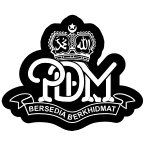 | |||
| Deputy Superintendent of Police (DSP) |  | |||||
| Assistant Superintendent of Police (ASP) |  | |||||
| Inspector (Insp) |  | |||||
| Probationary Inspector (P/Insp) |  | |||||
| Non-commissioned officers | Sub-Inspector (SI) |  |
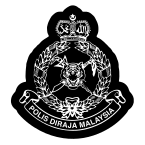 | |||
| Sergeant Major (SM) |  |
 | ||||
| Sergeant (Sgt) |  | |||||
| Corporal (Cpl) |  | |||||
| Constables | Lance Corporal (L/Cpl) |  | ||||
| Constable (PC) | ||||||
Lower ranks of police officers apart from Sub-Inspectors wear their rank insignia on the right sleeve of their uniforms. Sub-Inspectors and higher ranks wear their rank insignia on epaulettes on both shoulders.
RMP organisational structure
Apart from the two departments involved in the administration: Management Department and Logistics Department, the RMP have six departments involved in crime prevention: Criminal Investigation Division, Narcotics Criminal Investigation Division, Internal Security and Public Order Department, Special Branch, Commercial Crime Investigation Department and Traffic Enforcement and Investigation Department. All departments are led by the directors with the rank of Commissioner of Police (Army Equivalent rank of Three Stars General or Lieutenant-General).
Police heads
| Type | Appointment | Rank | Abbr | Officer | Effective | Ref. | |
|---|---|---|---|---|---|---|---|
| Inspector-General of Police | Inspector-General of Police of Malaysia | Inspector-General of Police | IGP | Tan Sri Dato' Seri Abdul Hamid bin Bador |
4 May 2019 | [8][9] | |
| Deputy Inspector-General of Police | Deputy Inspector-General of Police of Malaysia | Deputy Inspector-General of Police | DIG | Dato' Sri Acryl Sani bin Haji Abdullah Sani |
13 August 2020 | [10][11] | |
| Commissioner of Police | Police Commissioner of Sabah | Commissioner of Police | CP | Dato' Zaini bin Jass |
13 February 2020 | [12] | |
| Police Commissioner of Sarawak | Commissioner of Police | CP | Dato' Aidi bin Ismail |
2 March 2020 | [13] | ||
| Chief of Police | Johor Police Chief | Commissioner of Police | CP | Dato' Ayob Khan bin Mydin Pitchay |
6 March 2020 | [14] | |
| Kedah Police Chief | Commissioner of Police | CP | Dato' Zainuddin bin Yaacob |
8 April 2019 | [15] | ||
| Kelantan Police Chief | Deputy Commissioner of Police | DCP | Dato' Hasanuddin bin Hassan |
15 June 2017 | [16] | ||
| Malacca Police Chief | Deputy Commissioner of Police | DCP | Dato' Mat Kasim bin Karim |
8 October 2019 | [17] | ||
| Negeri Sembilan Police Chief | Deputy Commissioner of Police | DCP | Dato' Mohamad bin Mat Yusop |
22 July 2019 | [18] | ||
| Pahang Police Chief | Commissioner of Police | CP | Dato' Sri Abdul Jalil bin Hassan |
12 August 2019 | [19] | ||
| Penang Police Chief | Commissioner of Police | CP | Dato' Sahabudin bin Abdul Manan |
9 March 2020 | [20] | ||
| Perak Police Chief | Deputy Commissioner of Police | DCP | Dato' Razarudin bin Husain |
8 April 2019 | [15] | ||
| Perlis Police Chief | Senior Assistant Commissioner | SAC | Datuk Surina binti Saad |
10 September 2019 | [21] | ||
| Selangor Police Chief | Commissioner of Police | CP | Dato' Noor Azam bin Jamaludin |
4 February 2019 | [22] | ||
| Terengganu Police Chief | Deputy Commissioner of Police | DCP | Dato' Roslee bin Chik |
2 March 2020 | [23] | ||
| Kuala Lumpur Police Chief | Commissioner of Police | CP | Datuk Seri Mazlan bin Lazim |
9 November 2017 | [24] | ||
Staff departments
| Department | Rank | Abbr | Director | Effective | Ref. | |
|---|---|---|---|---|---|---|
| Commercial Crime Investigation Department (CCID) | Commissioner of Police | CP | Dato' Seri Mohd. Zakaria bin Ahmad |
17 June 2019 | [25] | |
| Crime Prevention and Community Safety Department (CPCSD) | Commissioner of Police | CP | Dato' Sri Rosli bin Abdul Rahman |
15 October 2018 | [26] | |
| Criminal Investigation Department (CID) | Commissioner of Police | CP | Dato' Huzir bin Mohamed |
17 June 2019 | [25] | |
| Integrity and Standards Compliance Department (ISCD) | Commissioner of Police | CP | Dato' Zamri bin Yahya |
6 August 2018 | [27] | |
| Internal Security and Public Order Department (ISPOD) | Commissioner of Police | CP | Dato' Sri Acryl Sani bin Haji Abdullah Sani |
15 October 2018 | [26] | |
| Management Department (MD) | Commissioner of Police | CP | Dato' Abdul Rahim bin Jaafar |
11 February 2019 | [28] | |
| Narcotics Crime Investigation Department (NCID) | Commissioner of Police | CP | Datuk Ramli bin Din |
2 March 2020 | [29] | |
| Special Branch (SB) | Commissioner of Police | CP | Dato' Mohamed Farid bin Abu Hassan |
17 July 2019 | [18] | |
| Logistic & Technology Department (Log) | Commissioner of Police | CP | Dato' Sri Tajudin bin Md. Isa |
15 October 2018 | [26] | |
| Traffic Enforcement and Investigation Department (TEID) | Deputy Commissioner of Police | DCP | Dato' Azisman bin Alias |
15 October 2018 | [26] | |
Management Department
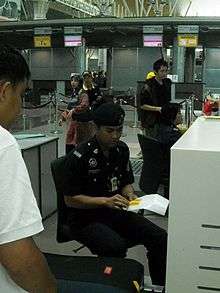
The Management Department is tasked with the routine of management and administration affairs of the RMP. This department is also the nerve centre of the RMP and acts as the support services platform for the rest of the force.
- Functions
- Service / Designation – Includes: Recruitment, Service Records Administration, Confirmations, Promotions, Transfers, Salaries & Allowances Administration and Retirements.
- General Administration And Policy – Includes: General Administration, Research & Development, Civil Affairs, Welfare, Sports And PERKEP (Persatuan Keluarga Polis or Police's Family Association, generally social activities for the families of the policemen)
- Training – Includes: Basic Course, Development Courses, Further Studies and Rehabilitation Courses.
- Branches
- Administration
- Welfare
- Training
- Research & Development
- Services / Designation
- Public Affairs
- Public Relations
- Intake
- Ceremonies
- Camp Commandant
- RMP Sports Council
Logistics and Technology Department
The Logistics and Technology Department provides equipment needed in the RMP.
- Functions
- Operate operating budget and RMP's development
- Plan, manage, operate and maintain communications, information technology, transport and weaponry
- Manage projects and maintain buildings and properties
- Manage turnover and supply of general equipment
- Manage RMP's assets
- Branches
- Naziran's Branch / Administration
- Communications Branch
- Information Technology Branch
- Transport Branch
- Finance Branch
- Technical Turnover
- Weaponry Branch
- General Turnover
- Part of the Building
- Disposal / Stock / Verification / Write-off
Criminal Investigation Division (CID)
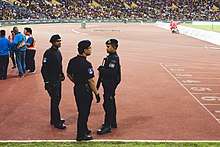
This department deals with the investigation, arrest and prosecution of both violent crimes such as murder, robbery, rape, etc., and less serious crimes such as theft and house-breaking. This department also specialises in investigating gambling, vice and secret societies (triads).
- Functions
- Investigations and detective duties
- Arrests and prosecutions
- Enforcement of laws related to gambling, vice and secret societies
- Branches
- D1 – Administrative Division
- D2 – Criminal Record Registration Division
- D3 – Anti-Human Trafficking / Migrants Smuggling Prevention Division
- D4 – Operation / Intelligence / Records Divisions
- D5 – Prosecution and Law Divisions
- D6 – Technical Assistance Division
- D7 – Gambling / Vice / Secret Societies Prevention Division
- D8 – Investigation / Planning Division
- D9 – Special Investigation Division
- D10 – Forensic Laboratory Division
- D11 – Sexual / Domestic Violence / Child Abuse Investigation Division
- D12 – National Centre Bureau-Interpol Division
- D13 – Databank DNA Division
- D14 – Organized Crime Investigation Division
The Criminal Investigation Division is headed by a Commissioner of Police (CP). The Unit Tindakan Cepat is attached to CID and based at all police contingent headquarters.
Narcotics Criminal Investigation Division
This department's function is to fight against dangerous drugs by enforcing the law to stop and reduce the demand and supply of dangerous drugs.
- Functions
- Enforce drug abuse and drug trafficking
- Collect, study, assess and spread drug-related information
- Investigate distributors activities and drug trafficking syndicates
- Fight drug smuggling activities including chemicals used to process drugs
- Implement prevention of drug abuse programs
- Exchange data/information with domestic and international agencies
- Keep records and statistics related to drug distribution and other drug-related matters
- Surveillance activity for former drug offenders or members formerly associated with drug trafficking syndicates
- Provide training locally/overseas for officers / members of narcotics department
- Attend the meetings, seminars related to drugs, locally/overseas
- Branches
- Special Investigation Divisions
- Coordinator Part / International-relations
- Administrative Divisions
- Detention Divisions
- Estate Stripping
- Interrogate
- Expert / Technical Assistance
- Record / Statistics
- Registration
- Logistics Divisions
- Airport Customs Staff
Narcotics Criminal Investigation Division led by Police Commissioner (CP).
Internal Security and Public Order Department (KDN / KA)
This department is tasked with the maintenance of public security and order. It is responsible for traffic control and search & rescue (SAR) operations. In this role, this department cooperates with other agencies, such as the Malaysian Armed Forces and Army / Navy Maritime Patrol to prevent piracy and to secure the national borders.
The Internal Security and Public Order Department is led by a Commissioner of Police, CP Dato' Salleh.
The main branches under this department are:
General Operations Force
The Police Field Force (PFF), organised in battalions, was once the para-military units of the Royal Malaysia Police. The force, which was also known as the Jungle Squad (Pasukan Polis Hutan (PPH) in Malay) was tasked to operate in the jungle fringes in counter-insurgency roles during the Malayan Emergency, Indonesia–Malaysia confrontations and later Communist guerrilla insurgencies along the Malaysian-Thai border and in the jungles of Sabah and Sarawak. When the Malayan Communist Party (MCP) and Clandestine Communist Organisation (CCO) finally gave up their armed struggle in 1989 and 1990, PFF lost its role. It was reorganised as the General Operations Force (GOF). The GOF has 19 battalions and the 19th Special Battalion is tasked to provide VIP security.
When established in 1948, the PFF had 19 battalions of which two were made up of indigenous people. These battalions were known as Senoi Praaq Battalions. One battalion was a Special Security Battalion.
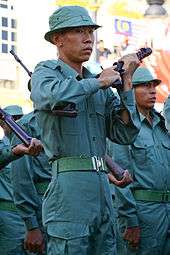
The 19 battalions are organised into five brigades, each headed by a Superintendent of Police. The North Brigade and Sabah Brigade have four battalions each, the Central Brigade has five battalions, and South-East Brigade and Sarawak Brigade have three battalions each.
It all began in the year 1948, when Malayan Communist Party murdered three European farmers at Sungai Siput, Perak and also murdered the three leaders of Kuomintang (Chinese Nationalist Party). Sir Edward Gent declared an emergency on 7 July 1948 in all Malaya Federations, starting with Perak on 16 June 1948 and Johore on 19 June 1948. To deal with the rebellion and to hunt down the Communist terrorists in the jungle, a military based team was formed in 1948. It was named the Flying Squad and later renamed the Jungle Squad, with its main mission to fight against the Communists. The first Jungle Squad unit was established at Sik, Kedah in 1949. Training centres were opened in Sungai Buluh, Selangor and in Dusun Tua, Hulu Langat, Selangor which was known as Field Force Special Training Centre (SLPPH). In 1964, SLPPH was transferred to Kroh, Perak then changed to Kentonmen, Ulu Kinta, Perak. After being renamed the General Operations Force or Pasukan Gerakan Am in 1997, SLPPH is now known as Sekolah Latihan Pasukan Gerakan Am (General Operations Force Training Centre, SLPGA).
So far, there are two Senoi Praaq battalions specialising in search and rescue operations. After VAT 69 was absorbed into Pasukan Gerakan Khas, along with anti-terrorist police force and Special Action Unit (UTK – Unit Tindakan Khas), a special platoon of PGA, Tiger Platoon was established.
Police Counter–Terrorism Units
When the seeming threat of global terrorism started to increase after the incident of 11 September in United States, followed up by several series of bombings in Bali and Jakarta, Indonesia and in Malaysia, the RMP has formed 2 anti-terrorism corps. These two elite forces are known as Pasukan Gerakan Khas (PGK) and Unit Gempur Marin (UNGERIN).
Pasukan Gerakan Khas
Pasukan Gerakan Khas is a major elite force in the Royal Malaysia Police, which is composed of 69 Commando (VAT 69) and Special Actions Unit (UTK).
This team was first merged in 1997 and became known as the Maroon Berets. However, this integration did not last and in 2003 it was separated. The VAT 69 changed to the Sandy Brown Berets, honoured by British 22nd Special Air Service (SAS). However, both units serve under the Pasukan Gerakan Khas and are under the command of a Senior Assistant Commissioner II.
This special counter-terrorism police team is also involved in some operations within Malaysia, including military operations with Malaysian Army 22nd Commando Regiment Grup Gerak Khas against the Al-Ma'unah organisation formed in Bukit Jenalik, Sauk, Perak. This team also served under the United Nations in Timor Leste and in the search and rescue operation of 700 officers and members of Indonesian National Police BRIMOB (Brigade Mobil) that were lost and trapped during the tsunami incident in Aceh, Indonesia at the end of 2005. This team also cooperated with Criminal Investigation Division to fight against dangerous crimes, among where the PGK successfully tracked down the notorious 'Gang M16' which comprised several ethnic Chinese criminals, including the group leader who was an ex-serviceman of Singapore, and the leader Gang 13 (Mat Komando), as well as other operations. The motto of VAT 69 is WARISAN DARAH PERWIRA (Literal meaning: INHERITANCE OF THE BLOOD OF WARRIORS), while for the UTK it is TANGKAS BANTERAS GANAS (Literal meaning: QUICK TO OVERCOME TERROR).
UNGERIN
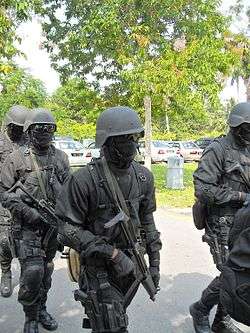
Unit Gempur Marin (UNGERIN) (Marine Combat Unit) was established in 2006 and it was fully operational by the end of 2007 with the first name as the Unit Selam Tempur due to the pressing need to suppress the pirate attacks alongside the coastal area of Malacca Straits and open sea area of South China Sea which were continuously widespread from time to time despite various efforts done to overcome the problem. The members received special training from the United States after realising the need to form a special unit to secure the national waters and river fronts from any untoward incidents. This unit is placed under formation Marine Police Branch which is based in the Marine Police Base at Kampung Aceh, Sitiawan, Perak and Lahad Datu, Sabah. It has a big role in handling threats from pirates, robbery, kidnapping and hijacking of ships and terrorist attacks in national waters. The 30 members of UNGERIN are trained by instructors from US Navy SEALs and US Coast Guard in Langkawi and Kota Kinabalu and are armed with special weaponry, such as Glock 19, MP5 and Colt M4A1 (possibly supported by the United States) and utilise maritime anti-terrorist tactics employed by the units of United States Navy commandos. For the unit's restructuring, the name of UST was changed to Unit Gempur Marin or UNGERIN in the year 2008.[30] Its eventual goal is to have 200 operators on standby with UNGERIN.[31]
In the first phase, the 30-personnel strong candidates is to undergo training in Langkawi and Kota Kinabalu, by instructors from Navy SEALs. Besides the basic diving training, they will be trained with other basic training, including tactical warfare, marksmanship, sniping, bomb disposal, direct action, sabotage, counter-terrorism, and intelligence gathering and paramedic training, along with special missions which are normally handled by special forces.[32]
Federal Reserve Unit
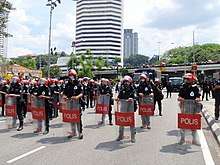
The Federal Reserve Unit (Malay: Pasukan Simpanan Persekutuan) is better known with the abbreviation FRU. Their role is riot suppression, crowd control, disaster relief and rescue, as well as special operations assistance. Established on 5 December 1955, it consisted of only 3 troops then. The FRU played a role in resolving some high-profile riots, including the racial riots of 13 May 1969 and in the combined operations to catch Ibrahim Libya in the Memali Incident of Baling, Kedah which ended with 16 deaths including Ibrahim and 3 police officers.
The FRU is directly under the Inspector-General of Police. This unit is independent and is able to be rapidly deployed.
As the premiere public order unit of the RMP, the FRU is designed, equipped and specially trained for duties in suppressing and dismissing riots and illegal assemblies. Aside from the stated roles above, the unit is also tasked with the following functions:
- Public Control – during mass public assembly, such as VIPs visitors, sports event, mass rallies and processions,
- To deal with pre and post “Chemical, Biological, Radiological And Nuclear" threats,
- Disaster Rescue assistance including floods, fires, train derailments, landslides, aircraft crashes, etc.; to rescue, prevent theft, and area inclusion involved,
- Crime prevention in helping a District Police Chief in the area which particular experience sharp rise frequent a crime rate or crime happened, to certain term,
- Massive operation, such as encircle and find, heat and arrested on extremist groups or gangster elements, intensive patrol and Curfew enforcement.
The FRU is led by a Commander, and assisted by a Deputy Commander. They report to the Director of Public Order. They are aided by a few Staff Officers and known as Commanding Headquarters. FRU each in led by one Commanding Officer. Every FRU troops in led by one Troop Officer. FRU training centre presided by a Commandant. Per unit and FRU training centre has a membership to aid the administration and known as group headquarters unit.
FRU was awarded a pennant flags in year 1971 and further replaced in year 1997. These pennants are given by King of Malaysia as an appreciate charity service and FRU service during a unit establishment for maintain a national public order. During official ceremonies where the FRU affect as a parent body or detachment; such as Guard of Honour, Mess Night of FRU or Parade in conjunction with Police Anniversaries and FRU Anniversaries, FRU banner may be issued and am being marched by directing and IGP approval, Internal Security and Public Order Director or FRU Commander.
C4-i Implementations System
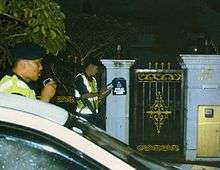
C4-i Implementation System (abbreviation for Command, Control, Communications, Computer-Integrated) unit is based at Police Control Centre in all police contingents in Malaysia. This unit is assigned to patrol the city and the suburbs. This unit was first established in Bukit Aman and Kuala Lumpur is the first contingent to implement this system. This unit is equipped with the CCTV system which is installed in different parts of the city and monitored by the Contingent Control Centre and each patrol car is also equipped with C4-i's system connected to a laptop. The C-4i also plays a role in forming Rakan Cops in 2006 to foster closer ties with the civilian community. Since then, the crime rates in major towns have decreased and brought about good reviews on the C4-i's and Rakan Cops implementation.
Mounted Police Unit
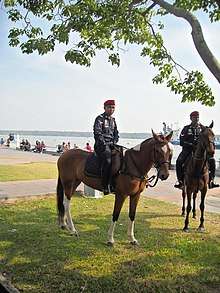
Traffic Branch
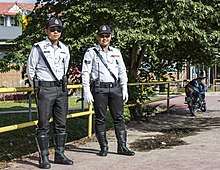
Problems in Malaysia began in the late 1920s when motorised vehicles began to hover on the road that used to be covered only by bicycle, tricycle, rickshaw and bullock carts. This situation creates a new task for the police forces, which is to maintain and control the traffic. In 1928 and 1929, the traffic branch was established in big cities, which is Kuala Lumpur, Ipoh and Seremban. Singapore, which at that time was part of Strait States have set up traffic branch earlier, which is in 1918. In other cities, the task of controlling the traffic falls on regular general duty policemen.
Because of the increasingly serious traffic problems due to the addition of vehicles, the traffic branch was set up in each state and other big cities gradually. In 1976, the central traffic branch was set up at the Bukit Aman. It is responsible for reviewing, designing and conducting research on traffic branch enforcement, training, engineering, records management and traffic law.
Marine Operations Force
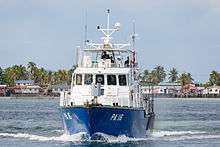
The Marine Operations Force or Malay: Pasukan Gerakan Marin is the Marine Police division tasked with maintaining law and order and co-ordinating search and rescue operations in the Malaysian Maritime Zone and on the high seas. Its responsibility was to maintain security at the parts in Penang and the Straits of Johor. On 6 February 2009, the name of Malaysian Marine Police was changed and known as Pasukan Gerakan Marin (English: Marine Operations Force). The rename of the organisation was launched by the Minister of Home Affair, Dato' Seri Syed Hamid Albar at PULAMAR (Abbreviation of Pusat Latihan Marin or Marine Police Training Centre), Tampoi, Johor Bahru and witness by Tan Sri Musa Hassan, the Inspector General of Police and all senior police officers and the media.[33]
It operates from five regional bases around the peninsula and East Malaysia. Each of these regional bases are organised similarly to the Neighbourhood Police Centres of the land divisions, and conduct patrols within their maritime sectors. The PGM conducts round-the-clock patrols in Malaysian territorial waters from its five regional bases, in an area of more than 142, 393 km2 and 450, 233 km2 for EEZ as well as 4490 km for the coastlines. It is also responsible for maintaining law and order on most of Malaysia's islands. The PGM use 15 PZ class patrol boats, 33 PX class, 68 PA/PT/PC/PLC and 4 PSC/PGR/PAR class patrol boats. The branch have five main bases, 11 small bases and 24 forward bases.
Malaysian Control Centre
Royal Malaysian Police Air Operations Force (Formerly Royal Malaysian Police Air Wing Unit)
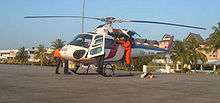
Royal Malaysia Police Air Operations Force or Pasukan Gerakan Udara (PGU) is a special aviation unit of Royal Malaysia Police. It has a vital role in maintaining national security with thorough surveillance and patrol from the air. Established on 1 February 1979. The commander of the unit was known as Air Wing Chief initially. Started police operations with 4 Cessna CU 206G officially on 7 April 1980 with operations focused in Peninsula of Malaysia. Now, PGU owns 10 helicopters AS355 F2 and N series, 6 CE 208 Caravan, 5 Pilatus PC-6 Porter, 4 Cessna 172Sp, and 5 Beechcraft KingAir 350 (KingAir 350 is an advanced aircraft with latest Proline-21 avionics system). Police Air Unit has 4 bases in Sultan Abdul Aziz Shah Airport (Subang Airport), PLUUP (Ipoh Airport), Sarawak Base (Kuching International Airport) and Sabah Base (Kota Kinabalu International Airport).
Special Branch
This department is responsible for collecting intelligence for national security. Its role is to collect security intelligence related to both domestic and external threats, intercept subversive activities by extremist groups and individuals which could threaten the nation's stability. Also, it is in charge of obtaining, processing, evaluating and disseminating information to other departments and organisations. This department is divided into several branches: Technical Intelligence, Social Intelligence, External Intelligence, Political Intelligence, Economic Intelligence And Security Intelligence.
The Special Branch is headed by a Commissioner of Police (Currently: Mohd Fadhli Bin Mohd Noh, G/8786).
Commercial Crimes Investigation Department
This department's main function is to investigate, arrest, and prosecute offenders committing white-collar crimes such as fraud, breach of trust, cyber-crimes, forgery, counterfeiting etc.
The Commercial Crimes Investigation Department is headed by a Commissioner of Police (CP).
Police Headquarters/Formation
Police Contingent
- Bukit Aman Royal Malaysia Police Headquarter, Kuala Lumpur 3.148725°N 101.691584°E
- Johor Contingent Police Headquarters, Johor 1.477227°N 103.764673°E
- Kedah Contingent Police Headquarters, Kedah
- Kelantan Contingent Police Headquarters, Kelantan
- Kuala Lumpur Contingent Police Headquarters, Kuala Lumpur 3.142093°N 101.707142°E
- Melaka Contingent Police Headquarters, Melaka
- Negeri Sembilan Contingent Police Headquarters, Negeri Sembilan
- Pahang Contingent Police Headquarters, Pahang
- Perak Contingent Police Headquarters, Perak
- Perlis Contingent Police Headquarters, Perlis
- Pulau Pinang Contingent Police Headquarters, Pulau Pinang
- Sabah Contingent Police Headquarters, Sabah
- Sarawak Contingent Police Headquarters, Sarawak
- Selangor Contingent Police Headquarters, Selangor
- Terengganu Contingent Police Headquarters, Terengganu
Marine Police Force
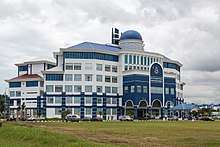
- Northern Region Marine Police Base, Batu Uban, Pulau Pinang
- East Region Marine Police Base, Kuantan, Pahang
- Southern Region Marine Police Base, Johor Bahru, Johor
- Sabah Region Marine Police Base, Sandakan, Sabah
- Sarawak Region Marine Police Base, Kuching, Sarawak
- Putrajaya Marine Police Base, Putrajaya
General Operation Force (GOF)
- Northern Region GOF Base
- Centre Region GOF Base
- South East Region GOF Base
- Sabah Region GOF Base
- Sarawak Region GOF Base
Air Police Force
- Peninsular Malaysia Region Air Police Base
- Sabah Region Air Police Base
- Sarawak Region Air Police Base
Commando Police Force
- 69 Commando Police Base
- Special Action Unit Police Base
Federal Reserve Unit (Anti Riot Police Force)
- 1st Federal Reserve Unit Base
- 2nd Federal Reserve Unit Base
- 3rd Federal Reserve Unit Base
- 4th Federal Reserve Unit Base
- 5th Federal Reserve Unit Base
- 6th Federal Reserve Unit Base
- 7th Federal Reserve Unit Base
- Women Federal Reserve Unit Base
- Horseman Federal Reserve Unit Base
Police Volunteer Reserve
Police uniform and equipment
The new Police Constable uniform was introduced in 2008. The headgear is a dark navy blue beret with a silver police force emblem on top of the left eye. Dark navy blue long sleeve shirts are worn along with dark navy blue cargo pants tucked into military boots. Before this, the police used to wear a khaki/brown uniform.[34]
A personal name tag is worn on the right side together with the police shield above it while the word "Polis" ("police" in Malay) is emblazoned in the other side. A police service number is under the name tag and a rank insignia on the right arm.
The Sam Browne belt was replaced by the brand new ballistic nylon police duty belt equipped with a standard issue Walther P99 or Px4 Storm handgun, two extra 10 round magazines, a pair of Hiatt Speedcuffs, a T-baton, a pepper spray, an LED torch and a walkie-talkie. Sometimes they are equipped with a Heckler & Koch MP5 sub-machine-gun during special situations.
Traffic officers wears white helmet or dark navy blue cap while on duty, a white long sleeve shirt with a reflective yellow vest, black riding pants with a yellow stripe and riding boots. Their equipment is the same as constables except that they have a whistle in their left pocket.
Firearms
1M4 Carbine; replacing M16 rifles, the future standard issue rifles supplied by SME Ordnance[35]
² Royal Malaysia Police has been acquired with new sub machine gun next generation from CZ Company from Czech Republic. The New CZ Scorpion EVO 3 A1 9mm caliber is the latest generation Scorpion Sub Machine gun as part new market from Eastern Europe and it will replace the existing MP5. [36]
Royal Malaysian Police Vehicles
¹ In early June, the Royal Malaysian Police (PDRM) began taking delivery of the first of its 425 new Honda Civic 1.8 S patrol cars which are equipped with RMPNeT communication equipment, dashboard cameras and digital video recorders, in order to replace Proton Wira and Proton Waja police cars in stages and will take on patrol and enforcement duties. The force is also set to add another 850 vehicles consist of 653 Civic 1.8s sedans and 197 units of Proton X70 SUV, bringing the total replacement of the vehicles to 1,275 units to completely modernise its patrol vehicle fleet.[37]
Major cases and incidents
Sulu militants intrusion in Sabah
Following the Sulu militants intrusion, a military standoff commenced on 11 February 2013 and ended after conflict about 24 March 2013.[38] 235 militants, most of whom were armed,[39] arrived by boat in Lahad Datu district from Philippines territory and occupied the village of Tanduo. They were sent by Jamalul Kiram III, a claimant to the throne of the Sultanate of Sulu. His stated goal was to assert the Philippine territorial claim to eastern Sabah as part of the North Borneo dispute.[40][41][42] In response, Malaysian security forces surrounded the village. Attempts by the Malaysian and the Philippine governments to reach a peaceful solution with Kiram's supporters were unsuccessful and the standoff escalated into an armed conflict on 1 March 2013.[43][44] At the end of the standoff, around 56 militants were killed along with six civilians and 10 Malaysian security forces (of which eight were Malaysian police members).[38][45] The rest of the militants were either captured or escaped back to the Philippines.[46][47]
Shooting of Aminulrasyid Amzah
A schoolboy, Aminulrasyid Amzah, was shot dead by police after allegedly trying to escape from a car accident which he was involved in. Aminulrasyid was driving his sister's car without a valid driver's licence after midnight on 3 May 2010, together with his friend, Azamuddin, who was the passenger. He had been trying to flee a number of motorcyclists who were chasing both boys after their vehicle had sideswiped a car earlier that night. After Aminulrasyid was shot, his friend Azamuddin was assaulted and beaten by the police but managed to escape. The IGP and the police have made many statements to the press saying that Aminulrasyid was trying to ram a police roadblock as well as carrying a weapon in the car. Azamuddin and Aminulrasyid's family has refuted many of the police claims. Many members of the public and the opposing politicians have criticised the police's response, alluding to the fact that the police are trying to cover up the incident and fabricate evidence. The boy's family has rejected calls for an inquest into the shooting because they did not believe they would receive a fair and transparent investigation, especially from the police. Instead, they have called on the government to establish a royal commission of inquiry to investigate Aminulrasyid's death. A special eight-member panel has been formed to scrutinise the investigation of the shooting; however, opposing politicians and the boy's family have derided the formation of the panel as a publicity stunt by the government.[48][49][50] On 24 March 2016, the High Court in Selangor awarded more than MYR400,000 in damages to the family of the victim to alleviate their pain and suffering.[51]
Recapture of Mas Selamat Kastari
The escaped terrorist, Mas Selamat Kastari, who escaped detention in Singapore in 2008, was nabbed by Bukit Aman and Johore Police while he was asleep in a secluded village house in Skudai, 25 kilometres (16 mi) northwest of Johor Bahru, Johore.[52][53] He found a traditional kampung house on stilts in Kampung Tawakal, a tiny village with a population of less than 100. Located about 10 km away from the North-South Expressway near the Kempas exit, it is almost impossible to locate for those not familiar with the area. The Singaporean terrorist, who captured world attention when he escaped from the republic's maximum security Whitley Detention Centre in February last year, could barely put up a fight in his shorts and T-shirt when caught during a dawn raid in April. At 6 am, about 30 armed policemen surrounded the kampung house and ordered Mas Selamat to come out. Police broke through two doors and rushed in when he refused to surrender.[54] He was arrested together with two others, Abdul Matin and Johar Hassan, by a PGK and police Special Branch officers following intelligence sharing with the police forces of Indonesia and Singapore. Police also seized documents and other paraphernalia that allegedly revealed their planned operation.[55] This report was later confirmed by both the Singapore and Malaysian governments, with the date of capture given as 1 April 2009.[56]
The Home Minister of Malaysia, Dato' Seri Hishammuddin Hussein, and Inspector-General of Police Tan Sri Musa Hassan at Putrajaya confirmed Mas Selamat was arrested and detained under the Internal Security Act.[57] Hishammuddin declined to give details since the case is sensitive as it involves intelligence agencies of Singapore and Indonesia, as well as Malaysia.[57] Musa said the arrest was made possible as police in Singapore, Indonesia and Malaysia had been sharing intelligence reports over the past year. It is learnt that Special Branch officers had been working on various leads since March and upon confirming his whereabouts planned the dawn raid that resulted in his arrest.[58][59]
Arrest of Nur Misuari
Nur Misuari who is the main leader and founder of one of the breakaway faction in the Philippines was arrested on 23 November 2001 together with six of his followers in Jampiras Island off Sabah after intruding past the Malaysian border illegally. Misuari is wanted in the Philippines for leading a failed rebellion against the Philippine government,[60] which he was later extradited to the Philippine authorities in December 2001 to face legal action in his country although Malaysia and the Philippines have no extradition treaty.[61]
Al-Mau'nah Arms Heist
In the early morning on 2 July 2000, 21 members of the militant group visited the outpost and camp of Bn 304 Rejimen Askar Wataniah under the guise of a surprise inspection and confiscated the soldiers' weapons and carted the weapons away from the armoury. They took away a huge cache of firearms and ammunition, including 97 M16 assault rifles, four GPMGs, five grenade launchers, 9,095 rounds of 5.56 mm and 60 rounds of 40 mm ammunition. The group was later cornered in the village of Sauk, Perak and involved in a stand-off with the Malaysian Army and Royal Malaysian Police forces. The Malaysian Special Forces threw a containment cordon around Bukit Jenalik. Tpr Matthew anak Medan from 21 Commando was murdered by this militant group and was awarded Pahlawan Gagah Berani.[62] The leader and militant group surrendered to the Malaysian Special Forces and later they were handed over to the police.[63]
The Al-Mau'nah group later surrendered, and the leaders were brought to trial for "waging war upon the King". Mohamed Amin Mohamed Razali and his group were brought to trial for charges of "waging war against the King" and became the first group of people convicted of such charges in Malaysia. Mohamed Amin Mohamed Razali and his two lieutenants, Zahit Muslim and Jamaluddin Darus, were sentenced to death. Sixteen others were given life sentences. Police Detective Korporal Sanghadevan was murdered during the incident.[64][65] Asisten Superintendan Polis Abdul Razak Mohd. Yusof was awarded the Seri Pahlawan Gagah Perkasa for his role in resolving the stand-off.
Memali Incident
The Memali Incident occurred in the remote village of Memali, Baling in the state of Kedah on 19 November 1985. A task force of 200 policemen under orders from the Acting Prime Minister and Home Minister Musa Hitam, laid siege to kampung (village) houses in Memali. The houses were occupied by an Islamic sect of about 400 people led by Ibrahim Mahmud a.k.a. Ibrahim Libya.[66]
Bukit Kepong Incident
The Bukit Kepong Incident was an armed encounter which took place on 23 February 1950 between the police and the Malayan Communists during pre-independence Malaya. This conflict took place in an area surrounding the Bukit Kepong police station in Bukit Kepong, a wooden station located on the banks of the Muar River, about 59 km from Muar town, Johor.
Royal Malaysia Police in popular culture
Books
- Malaya's Secret Police 1945–60: The Role of the Special Branch in the Malayan Emergency, 2008—the history of Malaysian Special Branch, written by former Special Branch officer, and a widely acknowledged expert on counter-insurgency, Leon Comber.
- The Struggle For Malaysian Independence, 2007—the history of Malaysian police force, written by former senior police officer, Dato' Seri J.J. Raj.
- Polis Wanita Sejarah Bergambar 1955–2007, 2007 – the history of Malaysian policewomen, written by Chief Inspector Selamat Bin Sainayune.[67]
- Smashing Terrorism in the Malayan Emergency: The Vital Contribution of the Police, 2004 – Written by Brian Stewart, a former officer of Malayan Civil Service (MCS).
- Inspektor Junid Di Medan Jenayah, 1987 – detective and mystery stories, written by Jalil Abd. Rahman, produced by Fajar Bakti[68]
- "Death Waits in the Dark" – Greenwood Press, 2001
- The Jungle Beat – Fighting Terrorists in Malaya – the history of Malayan police during fighting against communisme, written by former Federation of Malay State Police officers, Roy Follows.
Television
- Debu-Debu Kota (City Dusts) – Malay drama created and produced by Dato' Yusof Haslam
- Skuad Khas (Special Squad) – Malay drama created and produced by Dato' Yusof Haslam
- Gerak Khas – Malay drama created and produced by Dato' Yusof Haslam
- Roda-Roda Kuala Lumpur (Wheels of Kuala Lumpur) – Malay drama created and produced by Dato' Yusof Haslam
- CID 3278 – Malay drama produced by Rosyam Nor.
- Tragedi (Tragedy) – Malay drama broadcast on TV3
- VAT 69 - Warisan Darah Perwira – Malay documentary created by Jins Shamsuddin. Featured on ASTRO RIA.
- Metro Skuad – Malay drama created and produced by Dato' Yusof Haslam
- Pasukan Gerakan Marin – Marine Police Force drama starring Ashraf Muslim, Linda Hashim (S1 and S2), Sharnaaz Ahmad and Mardiana Alwi
- Kerambit – crime drama starring by Eman Manan and Zul Huzaimy on TV2
- Undercover – Chinese drama featured in NTV7 staring by Adrian Tan
Films
- Bukit Kepong – Malay film starring Jins Shamsuddin
- Bayangan Maut – Malay film starring Dato' Yusof Haslam
- Police Story 3 – Hong Kong Cantonese film starring Jackie Chan
- Entrapment – Hollywood film starring Sean Connery and Catherine Zeta-Jones
- Don - The Chase Begins Again – Bollywood film starring Shah Rukh Khan and Shaharudin Thamby (Malaysian actors)
- The Viral Factor – Hong Kong action thriller films stars Jay Chou and Nicholas Tse
- Polis Evo – Malay film starring Shaheizy Sam and Zizan Razak
- Kabali – Tamil film starring Rajinikanth
- J Revolusi – Malay film starring Zul Ariffin and Izara Aishah Hisham
- Iru Mugan – Tamil film starring Vikram
- KL Special Force – Malay film starring Dato Rosyam Nor and Fattah Amin
- Sindiket – Malay film starring Sharnaaz Ahmad, Daphne Iking and Dato Jalaluddin Hassan
- Polis Evo 2-Malay action film starring Shaheizy Sam and Zizan Razak
Documentaries
- 999 (Malaysian TV series),a based from Cops (TV program) who first aired in 2002
- OPS Maritim (OPS Maritime),about operation by Marine Police and other
Daily life
- Highway patrol
- Private properties – Uniformed police officers on duty are likely to hint property owner to "obey the law" to receive "protection" by police.
VCD/DVD
- Jungle Green Khaki Brown – A TV3 and Nickelodeon Books co-production DVD documentary chronicling exclusive and historical footage from the archives of the British Malayan Library in United Kingdom and the Filem Negara Malaysia in conjunction of the 50th Independence Day in 2007.
Complaints Commission
Non-governmental organisations continued to press the government to create an Independent Police Complaints and Misconduct Commission (IPCMC). In 2005 a Royal Commission of Inquiry into the police had recommended a wide range of reforms, including the establishment of an IPCMC by May 2006.[69] Draft legislation to establish an IPCMC remained under consideration by the Attorney General at the end of the year. A range of other reform recommendations, including repeal or review of laws allowing for detention without trial or requiring police permits for public assemblies, were not implemented.
See also
- Malaysian Armed Forces
- Malaysia Coast Guard
- Royal Malaysian Custom
- Anti-Corruption Agency
- Elite Forces of Malaysia
References
- "Indonesian, Malaysian police ramp up cooperation to fight transnational crimes". Xinhua News Agency. Global Times. 13 February 2014. Archived from the original on 12 May 2016. Retrieved 12 May 2016.
- "RP, Malaysia intensify joint effort vs terrorism, transnational crimes". The Philippine Star. 21 March 2002. Archived from the original on 12 May 2016. Retrieved 12 May 2016.
- Izam Said Ya'akub (2 December 2010). "Multilateral cooperation needed to counter transnational crime". The Brunei Times. Archived from the original on 12 May 2016. Retrieved 12 May 2016.
- "Thai, Malaysian police agree cooperation". The Nation. 14 May 2015. Archived from the original on 12 May 2016. Retrieved 12 May 2016.
- "Malaysia, Singapore police to work closely in combating cybercrime". Bernama. The Borneo Post. 5 May 2012. Archived from the original on 12 May 2016. Retrieved 12 May 2016.
- "Vietnam People's Police Force's 70th anniversary marked abroad". Voice of Vietnam 5. 20 August 2015. Archived from the original on 12 May 2016. Retrieved 12 May 2016.
- "Vietnam, Malaysia sign agreement on transnational crimes". Nhân Dân. 1 October 2015. Archived from the original on 12 May 2016. Retrieved 12 May 2016.
- "New IGP: I'm so honoured to be given the trust". The Star (Malaysia). 4 May 2019. Retrieved 4 May 2019.
- "Home minister says Hamid Bador is new IGP for next two years". Jerry Choong. Malay Mail. 2 May 2019. Retrieved 2 May 2019.
- Zolkepli, Farik; Camoens, Austin (13 August 2020). "Deputy IGP bids farewell to the force". Retrieved 13 August 2020.
- Aiman, Ainaa (13 August 2020). "Acryl Sani is acting deputy IGP". Free Malaysia Today. Retrieved 13 August 2020.
- "Zaini Jass is new Sabah police commissioner". Bernama. The Star (Malaysia). 13 February 2020. Retrieved 14 February 2020.
- "Datuk Ramli Din among 37 senior officers involved in transfers". Bernama. The Borneo Post. 2 February 2020. Retrieved 3 February 2020.
- Zolkepli, Farik (6 February 2020). "Ayob Khan appointed new Johor police chief". The Star (Malaysia). Retrieved 14 February 2020.
- "Police announce transfers involving 20 senior police officers". Bernama. The Star (Malaysia). 5 March 2019. Retrieved 9 August 2019.
- Jaafar, Sulaiman (15 June 2017). "Hasanudin Hassan is new Kelantan police chief". New Straits Times. Retrieved 9 August 2019.
- "Datuk Mat Kasim Karim named new Melaka police chief". Bernama. Malay Mail. 7 September 2019. Retrieved 7 September 2019.
- "PDRM announces transfers, new appointments". The Borneo Post. 22 June 2019. Retrieved 9 August 2019.
- "Abd Jalil Hassan to be new Pahang police chief next month". Malay Mail. 13 July 2019. Retrieved 9 August 2019.
- Liew, Jia Xian (9 March 2020). "Penang gets new police chief". The Star (Malaysia). Retrieved 15 August 2020.
- "Police announce transfers of senior officers". Bernama. Malaysiakini. 9 August 2019. Retrieved 9 August 2019.
- Zolkepli, Farik (4 February 2019). "Noor Azam Jamaludin is new Selangor police chief". The Star (Malaysia). Retrieved 9 August 2019.
- Raja Rahim, Raja Noraina (1 February 2020). "Ramli Pengarah JSJN Bukit Aman baharu" (in Malay). Harian Metro. Retrieved 3 February 2020.
- Timbuong, Jo (10 October 2017). "Comm Datuk Mazlan Lazim is new KL Police chief". The Star (Malaysia). Retrieved 9 August 2019.
- "Bukit Aman announces new CID, CCID directors". New Straits Times. 15 May 2019. Retrieved 9 August 2019.
- Hadzman, Maszureen (13 September 2018). "PDRM umum 10 pegawai kanan bertukar" (in Malay). Utusan Malaysia. Retrieved 9 August 2019.
- Yaacob, Mohd Azam Shah (6 July 2018). "20 pegawai kanan PDRM bertukar" (in Malay). Berita Harian. Retrieved 9 August 2019.
- "PDRM announce transfers, promotion of 32 senior officers". Malay Mail. 11 January 2019. Retrieved 9 August 2019.
- "Ramli Din dilantik Pengarah JSJN baharu". Bernama (in Malay). Sinar Harian. 1 February 2020. Retrieved 3 February 2020.
- "Marine bases to serve as coastal police stations". Daily Express. 25 November 2008. Retrieved 3 March 2009.
- "擴展服務範圍水警兼管查案" (in Chinese). China Press. 21 April 2009. Archived from the original on 5 May 2009. Retrieved 3 April 2009.
- "Unit Selam Tempur – miliki kemahiran ala komando" (in Malay). Utusan Malaysia. 27 July 2008. Retrieved 18 August 2008.
- "Polis Marin kini Pasukan Gerakan Marin" (in Malay). Utusan Malaysia. 7 February 2009. Retrieved 4 March 2009.
- http://www.capitalpunishmentuk.org/fandey.html
- "M4 carbine also used by Royal Malaysia Police, Malaysian Maritime Enforcement Agency and others". SME Ordnance Sdn Bhd. Retrieved 13 September 2008.
- Defaiya, Al (23 April 2014). "Al Defaiya | CZ to Supply 400 Submachine Guns to Malaysian Police". www.defaiya.com. Retrieved 7 March 2020.
- "Proton X70 to join Honda Civic in PDRM patrol fleet - paultan.org". Paul Tan's Automotive News. 24 June 2020. Retrieved 27 June 2020.
- Kronologi pencerobohon Lahad Datu (video) (in Malay). Astro Awani. 15 February 2014. Event occurs at 1:20. Retrieved 27 February 2014.
- "Philippines' Aquino calls for talks on Sabah". Agence France-Presse. Yahoo! News. 17 March 2013. Retrieved 17 March 2013.
- "Heirs of Sultan of Sulu pursue Sabah claim on their own". Philippine Daily Inquirer. 16 February 2013. Retrieved 20 February 2013.
- Michael Lim Ubac; Dona Z. Pazzibugan (3 March 2013). "No surrender, we stay". Philippine Daily Inquirer. Retrieved 3 March 2013.
- Jethro Mullen (15 February 2013). "Filipino group on Borneo claims to represent sultanate, Malaysia says". CNN. Retrieved 25 February 2013.
- M. Jegathesan (5 March 2013). "Malaysia attacks Filipinos to end Sabah siege". Philippine Daily Inquirer. Retrieved 5 March 2013.
- "Lahad Datu: Malaysian security forces in all out attack against Sulu gunmen". The Star. 5 March 2013. Retrieved 5 March 2013.
- Najiah Najib (30 December 2013). "Lahad Datu invasion: A painful memory of 2013". Astro Awani. Retrieved 30 December 2013.
- "Lahad Datu: Sabah CPO – No halt to Ops Daulat until Sulu terrorists are flushed out". The Star. 30 March 2013. Retrieved 30 June 2014.
- "Dakwaan anggota tentera terbunuh hanya taktik musuh – Panglima Tentera Darat" (in Malay). Astro Awani. 12 August 2013. Retrieved 30 June 2014.
- "Cop's trial in Aminul shooting case on Oct 12". The Star. 23 June 2010. Retrieved 14 July 2010.
- "Investigation papers on Amunlrasydi's death submitted to DPP for court action". Sin Chew Daily. 12 July 2010. Retrieved 14 July 2010.
- "Friend recounts eventful night out with Aminulrasyid". The Star. 4 May 2010. Retrieved 14 July 2010.
- Maizatul Nazlina (24 March 2016). "Aminulrasyid's family awarded RM400,000 in damages". The Star. Retrieved 25 March 2016.
- "Singapore's JI leader Mas Selamat reportedly arrested in Malaysia". Channel NewsAsia. 8 May 2009. Retrieved 9 May 2009.
- "Singapore terrorism suspect held". BBC News. 8 May 2009. Retrieved 11 May 2009.
- Meera Vijayan (11 May 2009). "Fugitive militant finds rustic retreat away from prying eyes". The Star. Retrieved 11 May 2009.
- Lourders Charles (8 May 2009). "Fugitive Mas Selamat nabbed". The Star. Retrieved 9 May 2009.
- "Singapore government confirms arrest of Mas Selamat". Channel NewsAsia. 8 May 2009. Retrieved 9 May 2009.
- "We will ensure Mas Selamat does not escape". New Straits Times. 9 May 2009. Archived from the original on 10 May 2009. Retrieved 10 May 2009.
- Lourders Charles; Dharmender Singh (15 January 2009). "Mas Selamat JI leader nabbed in Skudai". The Star. Retrieved 21 January 2009.
- Leslie Lopez (8 May 2009). "Mas Selamat captured". The Straits Times. Archived from the original on 15 May 2009. Retrieved 9 September 2009.
- "Philippines rebel leader arrested". BBC News. 25 November 2001. Archived from the original on 26 September 2015. Retrieved 26 September 2015.
Malaysia's Inspector-General of Police Norian Mai said Mr Misuari and six of his followers were arrested at 3.30 am on Saturday (1930 GMT Friday) on Jampiras island off Sabah state. Manila had ordered his arrest on charges of instigating a rebellion after the government suspended his governorship of an autonomous Muslim region in Mindanao, the ARMM. Although the Philippines has no extradition treaty with Malaysia, the authorities have already made clear that they intend to hand Mr Misuari over to the authorities in Manila as soon as possible. Malaysian Prime Minister Mahathir Mohamad had said before the arrest that, although his country had provided support to the rebel group in the past in its bid for autonomy, Mr Misuari had not used his powers correctly. "Therefore, we no long feel responsible to provide him with any assistance," he said.
- "Nur Misuari to be repatriated to stand trial". Australian Broadcasting Corporation. 20 December 2001. Archived from the original on 5 July 2014. Retrieved 5 July 2014.
- "Malaysian arms gang took hostages". BBC News. 4 July 2000. Retrieved 8 June 2008.
- "Malaysian gunmen surrender". BBC News. 6 July 2000. Archived from the original on 21 December 2010. Retrieved 18 August 2008.
- "Sauk incident". Utusan Malaysia. 15 January 2001. Retrieved 18 February 2008.
- "Malaysian arms raid cult charged". BBC News. 8 August 2000. Archived from the original on 21 December 2010. Retrieved 8 June 2008.
- Yusoff Kamaruzaman. "Islamic Radicalism in Malaysia: the Middle East connection)" (PDF). Durham University. Archived from the original (PDF) on 30 September 2005. Retrieved 14 August 2006.
- Polis wanita: sejarah bergambar, 1955–2007 (in Malay). Kelana Publication. 2007. ISBN 978-983-42258-0-3.
- Inspektor Junid di Medan Jenayah (in Malay). Fajar Bakti. 1987. ISBN 978-0-19-580961-9.
- "No more foot-dragging". Aliran Monthly. Archived from the original on 19 November 2007. Retrieved 1 December 2006.
.jpg)
